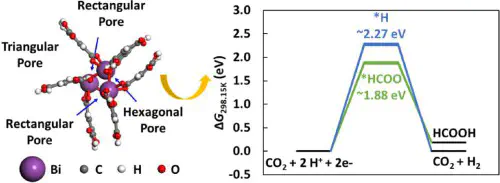Highly Stable Two-Dimensional Bismuth Metal-organic Frameworks for Efficient Electrochemical Reduction of CO2

Abstract
We report a unique 2D bismuth metal-organic framework (Bi-MOF) that possesses permanent accessible porosity for efficient electrochemical CO2 reduction (ECR) to HCOOH. The 2D open-framework structure with helical Bi-O rods bridged by tritopic carboxylate ligands exhibits a remarkable Faradaic efficiency for HCOOH formation over a broad potential window, reaching 92.2 % at ∼ –0.9 V (vs. reversible hydrogen electrode, RHE) with excellent durability over 30 h. The mass-specific HCOOH partial current density is up to 41.0 mA mgBi−1, exceeding 4 times higher than that of commercial Bi2O3 and Bi sheets at ∼ –1.1 V (vs. RHE). Operando and ex-situ X-ray absorption fine structure spectroscopy revealed a structural feature associated with Bi-MOF to preserve Bi(3+) during and after long-term ECR. Theoretical calculations further showed that the crystallographically channels with abundant Bi active sites in the MOF structure favor the formation of *HCOO while suppressing the side-reaction of hydrogen evolution, thereby leading to the high selectivity for HCOOH.